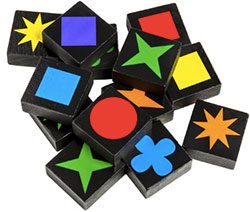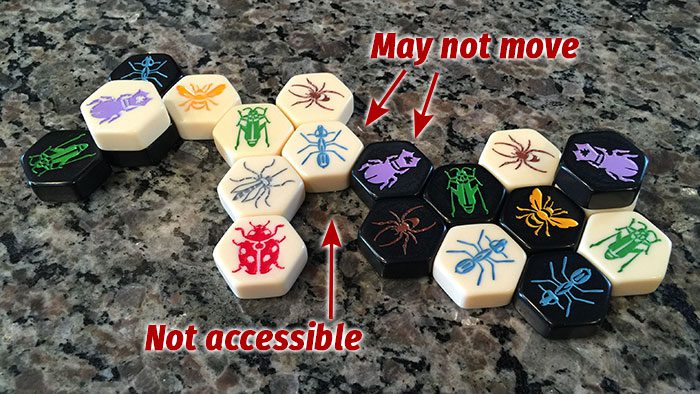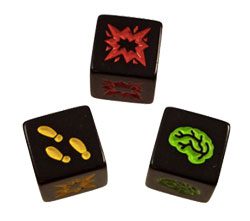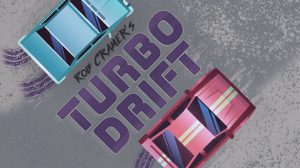My kids and I were playing outside in the yard yesterday and it was absolutely glorious. Cool, breezy, sunny, all of the things you love about the summer months. We laid a blanket down in the soft grass in the shade of a tree and just relaxed. The only thing that could have made it better was a game! Board gaming is generally considered an indoor activity, but it doesn’t have to be! With this list of my Top 6 games for Patio Play you can catch some rays, play some games and not worry about the wind or even the rain!
Qwirkle by Susan McKinley Ross
Qwirkle is an abstract strategy game of matching colors, and shapes. Sounds similar to other games, so what’s Qwirkle have that others don’t? First off is the pieces: they’re about an inch square and a half inch tall, made of glossy black lacquered wood. Each Qwirkle piece displays one of six shapes (stars, circles, squares, sunburst, clovers and diamonds), in one of six bright colors (red, orange, blue, purple, green, and yellow). These pieces are heavy enough that only a Twister could move them. But how does Qwirkle play?

In Qwirkle, players take turns placing one or more pieces from their personal collection of 6. When placed on the board a piece must either match the same color (in which case all shapes in that row must be unique), or match the same shape (in which case all colors in that row must be unique). Players score a single point for each piece in the row where their piece landed. If there are already 3 pieces and you add a 4th, you get 4 points. If your piece can cross 2 rows, then score for each piece in both rows. Because of the color/shape restriction, rows can be no more than 6 pieces long. The player who is able to place the final matching piece in a row, will receive a bonus of 6 points, called a Qwirkle). Draw up to your piece limit of 6 after your turn is over. The player with the most points when all pieces have been played is the winner.
Qwirkle is a delightfully fun game for both children and adults. It’s an abstract strategy game, but it helps children with their colors and shapes. The pieces are heavy and waterproof so they won’t blow away outside, and they can even get wet if it starts raining. Qwirkle is an excellent game and one which belongs in everyone’s collection.
Hive by John Yianni
Hive by John Yianni is a two player strategy game that could make you forget about chess. The hexagonal pieces are made of heavy bakelite plastic, the same material as dominos, and come in two colors. Each piece displays a different “critter”: ants, spiders, beetles, grasshoppers and even ladybugs, mosquitos and pillbugs (the latter 3 via expansions) whose job it is to protect the queen bee pieces.
Hive doesn’t use a board; instead each hexagonal tile is placed onto the table in specific patterns, then moved on later turns. Each piece has a different, distinct type of movement. Most pieces are sent around the table in a sliding motion, which gives an interesting physical twist to the game. In many cases, the piece you’re moving won’t actually fit where you want it to go.
Each piece has their own distinct movement style, but all pieces are subject to the same overriding rules:
- One Hive Rule: At no time can one piece move such that the hive splits into two separate parts.
- Freedom to Move Rule: Movement is accomplished by a sliding motion (except for Grasshoppers and Beetles). This means that if a piece cannot physically slide into, or out out from, a location it cannot be moved.

Ants, spiders, and the queen bee move around the outside of the hive. Grasshoppers, beetles, ladybugs are able to move over the top of the hive. Finally the mosquito is able to impersonate any other insect it touches! The goal of Hive is to completely enclose your opponent’s queen, while preventing the same from happening to yours.
Hive is a brilliant tactical game. It’s challenging and thinky, yet plays fast. The pieces are dense and heavy, and completely waterproof; you could even play this one in the pool if you liked…underwater! Hive is perfect for patio play, or anywhere for that matter!
Read my complete review of Hive.
Mancala
Mancala is an old game…at least 1300 years old. The game is an excellent one, pitting opponents against each other in a race to collect the most pieces. Each player starts with 4 pieces in each of 6 pots on each side of the board. An additional scoring pot is located at the end of each board with the one on a players right belonging to them.
On a player’s turn they will pick up all of the pieces in one of the pots on their side of the board. They will then move clockwise dropping one piece in each of the pots until they run out of pieces. Any piece landing in their scoring pot will count towards their score at the end of the game. Players will skip over their opponents scoring pot if they make it that far. A few additional rules allow for more strategic play. If a player’s last piece winds up in their scoring pot, they may take another turn. If a player piece winds up in an empty pot on the their side of the board, then they may claim all of their opponent’s pieces in the pot directly opposite their piece. The player with the most points at the end of the game.
Mancala is a perfect outdoors game, in fact the earliest records of this game were of game boards dug into the dirt. You can literally play Mancala with dirt and rocks! Modern Mancala boards are generally made of glossy wood with marbles, so they’re perfectly happy to get a little wet, and the heavy marbles aren’t going anywhere. Get this one to your patio and starting playing!
Zombie Dice by Steve Jackson
Zombie Dice is a clever little push your luck dice game. With only 13 dice it’s easily the most portable game on this list. In Zombie Dice players are everyone’s favorite undead character, the zombie, and are trying to eat brains. Players are trying to be the first one to score 13 brains over a single turn (if they’re unbelievably lucky), or multiple turns if they play it safe.
On player’s turn in Zombie Dice they’ll randomly pull 3 dice from the carrying case and roll them. The die faces are made of up 3 symbols: brains, feet, and explosions. If a player rolls feet, that die remains in the middle of the table. If the player rolls a brain or an explosion, they put that aside and determine if they want to continue rolling. If they decide to continue rolling then they pull out enough dice to get to 3 (feet dice from the previous turn go back into the active die pool). If a player rolls 3 explosions before they decide to stop, they lose all brains collected that round and the dice move to the next player. The first player to 13 brains is the winner.

Zombie Dice is just pure mindless fun (see what I did there?). It’s simple enough you can teach it to someone in less than a minute. Games usually take 5 minutes or so, and can play essentially any number of players. Play it on the patio, in the sandbox, or even laying on a blanket under a clear blue sky.
Battle Sheep by Francesco Rotta and Andrea Femerstrand
Battle Sheep is an abstract, area control strategy game with the cutest theme ever! In Battle Sheep players take control over flocks of sheep trying to dominate a pasture made of hexagonal tiles. Each tile consists of 4 hexes and the first thing you do in the game is build the pasture! Super clever.
When the pasture is built, players place all 16 of their sheep tokens in a single stack of 16 tokens. On a turn a player may choose to move a portion of any stack in any direction, in a straight line until she stops (leaving at least one sheep in the existing space). The winner of the game is the player who has the most occupied spaces.
The components in Battle Sheep are marvelous bakelite tokens. Dense, thick, and heavy with the most amazing illustrations of sheep belching, or showing their posteriors, or winking salaciously.

Read my complete review of Battle Sheep.
Blokus Trigon by Bernard Tavitian
Blokus: Trigon is a variation on the best-selling board game Blokus. In Blokus: Trigon, players lay down clear plastic tiles onto a game board. Each tile is comprised of between 1 and 6 triangles, each tile is unique, and each player has an identical set. The goal of the game is to place as many of your tiles onto the board as possible, and wind up with the lowest score. At the end of the game each individual triangle on each remaining piece is counted against you.
On each turn a player will place a single tile, somewhere on the board. The only rule is that a tile must touch at least one other tile of their color, and may only touch her other tiles at corners, and not along the edges. Play continues until all players have placed all of their tiles, or cannot place any more tiles. The player with the lowest remaining triangle count is the winner.
Blokus might be an abstract game, but it’s beautiful to look at. The pieces are crystal clear translucent plastic in blue, red, green, and yellow. The pieces are thick and actually click into place along raised lines in the board. Clearly this was a game designed to allow for bumps and breezes. Play this one on the patio and you’ll spend your time in the sun pondering the best possible moves for your next tile.
Honorable Mentions
It wouldn’t be a top 6 list without a few games that didn’t quite make the cut. Here’s a few more games that could stand up to the wind on your back porch!
Rolling America
Rolling America is a light, fun dice rolling game with very few components: just 7 dice and a scoring sheet per player. In Rolling America players pull 2 dice from the bag. Each player then must mark that die number in one of the colored regions on a pixelated map of the US (color must match color). Additionally, each newly placed number must be within 1 number of any number which it touches. Want to put a green 4 onto your board, then it can only touch a 3, 4, or 5. The score sheets are a draf but if you have access to a laminator, then laminate them and bring along a dry erase marker. Perfect patio or poolside fun!
Crab Stack
In Crab Stack players command an army of crabs of varying sizes. Giant heavy slow crabs, medium sized crabs, and tiny nimble crabs. The goal of the game is to be the last player able to move your crabs. You do this by forcing your opponents crabs to be washed away, or by stacking your own crabs on top of their crabs, preventing them from moving. Big crabs can be on top of any sized crabs, while tiny crabs can only be on top of other tiny crabs. Additionally, each crab may only move according to their size. Large crabs moving one space; tiny nimble crabs moving 3. The pieces are heavy wood pieces with fun illustrations and an interesting theme. Crab Stack will make you think your back porch opens out onto the sea.
















